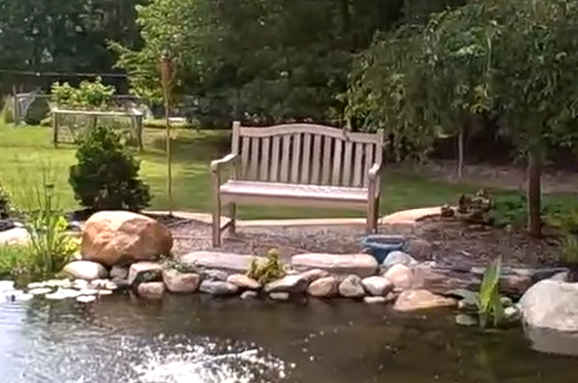Ponds, Streams & Waterfalls
When my client purchased a home at the top of a steep ravine, all she really knew was that she owned a lengthy stretch of a streambed and the land rising above it on both sides. At some point after she moved in, she decided to beautify the space, had a load of 200 boulders dumped in the driveway and hired her landscaper to move them down to dress up the waterway, which was dry through most of the year and was overgrown with all sorts of unwelcome plants. What she didn't know was that she was fooling around with Kenter Creek, a federally protected Blue Line waterway that started high in the hills a couple miles away. She had figured, reasonably so, that the stream was
It doesn't happen every time. But as Mike Gannon reports here, new ponds will head in this disturbing direction often enough that he prepares all of his clients to deal with a distressing transformation that can occur within weeks after a pond has been filled with water for the very first time.
'As modern building materials have been developed,' wrote Japanese garden specialist Douglas M. Roth in October 2003, 'we humans have been remarkably proficient at applying them in ways that go well beyond the vision of their inventors. Such is the case with roofing membranes, which now are widely used as liners for backyard streams and ponds. 'It's understandable that landscape designers and contractors have taken to these rubber liners. After all, they make pond and stream construction inexpensive and easy. But from the perspective of the Japanese gardener or quality watershaper, convenience and affordability alone do not
My work as a landscape architect is usually recognized for two distinguishing characteristics - first for the inspiration I draw from my friend and mentor, the late, great Brazilian environmental artist Roberto Burle Marx, and then for my driving ambition to preserve and restore habitats, as expressed in projects throughout South Florida and across the Florida Keys and various islands in the Caribbean and the West Indies. This is why seeing the project discussed here comes as something of a surprise to many who are familiar with my work: It's located in Big Timber, Mont., a blip on the road between
As I've gotten better at what I do as a watershaper, I've found that lots of the maturing has been related to getting really good at listening to my clients. Once I figured out how to attune myself to their visions and voices and set aside my ego (however temporary that might be), I found that my designs crackled with new energy I was borrowing from people who wanted my help in expressing themselves. That's the artistic, inspired side of watershaping, of course, and as my listening skills grew and my projects took on new and sometimes
For a watershaper who's spent a career designing and installing natural-looking ponds, streams and waterfalls using pumps and liners, this project was both an unusual treat and a distinct challenge - a dream job, as I saw it. I was called to the property at the suggestion of a landscape-maintenance company that wanted nothing to do with what the homeowners were asking, and the reason was pretty obvious: A spring-fed stream flowed across the property as it had done for at least hundreds and perhaps thousands of years, and it needed
In any large-scale watershaping project, managing the logistics has a way of becoming the most important task of all. In the case under discussion here, that might even be an understatement when you weigh all of the complicating factors. First, the job site was located in central Colombia, in the foothills of South America's Andes mountain range. Second, that locale is essentially a tropical rainforest, and when it wasn't pouring by the bucketful, it was crushingly hot and humid. Third, ours is a North American company that works with its own products and has no distribution in Colombia. And there's more: To get the job done, we knew we
When a pond's fish shift to spawning mode, all sorts of things start happening in a hurry -- in turn whipping new pond owners into a frenzy right alongside their fish. At these times, Mike Gannon counsels restraint and helps novices recognize and follow what's happening.
In the last video I shared with you, I relayed information about upgrading a do-it-yourself pond into a watergarden that exemplifies the value of an informed, professional touch. This time, a pond we updated was large enough that I know it was installed by a professional - but one who at the time seems to have been a bit lacking in insight and imagination. There's only a brief glimpse of




















